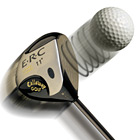
Diane Mucha/Jim Herity
|
Fightin' words
The USGA comes out counter-punching in the equipment wars
By Frank Hannigan
Golf Digest
|
After being pummeled verbally for three years, the U.S. Golf Association has bounced off the ropes with a flurry to Ely Callaway and his nonconforming ERC II driver. The blows landed where aimed--below the belt.
The USGA has said scores made with the ERC II and other super-springy drivers may not be turned in for handicapping purposes. Later, the USGA affirmed its position. Then, just to be sure nobody missed the point, the USGA sent out an all-points bulletin conveying the same message.
Since the 4.5 million golfers with USGA handicaps are the game's most susceptible buyers, a move removing them from the realm of respectability could affect Callaway's bottom line. Essentially, what the USGA is saying is, "Come on, big guy, you talk a lot; let's see you sue us."
The disputants say there's nothing personal in their quarrel. Ha! It's all personal. They really and truly dislike each other. Callaway labels the USGA as a cistern of Eastern elitism. The USGA regards him as one whose only connection with golf is to wrench money out of it.
The USGA covers up by not publicly besmirching Callaway or his spokesperson, the revered Arnold Palmer, whose message is that golf needs at least two sets of rules: one for those who compete at some nebulous level, and one for "recreational" golf.
The USGA finds the very concept of split rules contemptible. Asked if they realize slamming the door on handicaps might affect sales of the ERC II driver, USGA people purr innocently, saying they have only responded to floods of questions.
The decision is consistent with others holding that you can't earn a handicap with nonconforming equipment but wildly at odds with one the USGA wishes it never issued. The mistake, promulgated in 1994, says it's OK to return scores for handicapping when the golfer uses a range finder, an example of a bureaucratic screw-up. It slipped out when the USGA handicap people were not talking to the USGA rules people.
The USGA insistence on a direct link between the playing rules and handicapping is flawed. The rules are necessarily precise--e.g., you can find case law proving that a dead land crab in a bunker is a loose impediment rather than an obstruction, meaning the deceased can't be moved without penalty. But handicapping can never be more than an approximation of current playing ability, enabling golfers of diverse skills to compete artificially.
The USGA Handicap System is a triumph of political skills, not mathematics. It is accepted everywhere because of compromises made long ago to ameliorate wild men in outbacks like Chicago and California who thought there could be only one true method of handicapping--theirs.
While there is a kind of logic in banning scores made with equipment outside the rules, that logic pales in the face of tolerances built into the system for match play when holes are commonly not completed because of concessions or, in four-ball play, when a partner simply picks up. Other examples of under-counting allow taking a first-tee mulligan or recording net pars on a round started but not completed because of bad weather.
Moreover, the system says scores should be posted when winter rules are played. Anybody who thinks a driver that may or may not yield a few more yards will affect scoring more than picking the ball up and placing it is deranged.
On the other hand, we have the erstwhile King, Arnold The Credible, quoted to the effect that his daughter could cut 10 strokes off her scores armed with her ERC II.
Dean Knuth, once known as the USGA Pope of Slope, told me that the average woman golfer would have to gain 120 extra yards per round in driving distance to pick up one stroke. Thus, Arnold seems to say that his daughter has found 1,200 yards, or 85 yards per drive. Who would not want to pay $500 and more for such a miracle?
This conflict will not drag on eternally. In a couple of years, or less, the ERC II may be commonly used. If so, the American golfer will have ignored or rejected the USGA.
The other possible outcome is that the ERC II and its brethren will earn their makers a few bucks and then float off to the netherland of golf where dwell other panaceas of yesteryear.
Frank Hannigan, a Contributing Editor to Golf Digest, was the executive director of the U.S. Golf Association from 1983-'89.
April 2001
|










